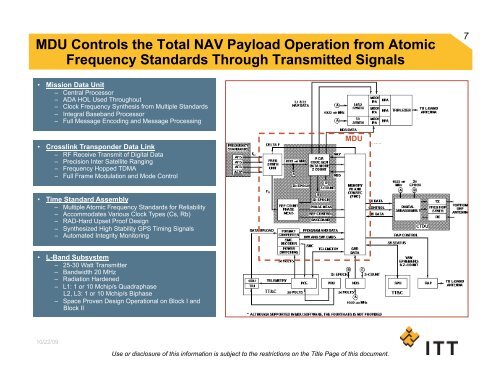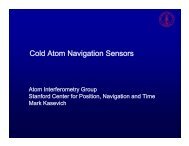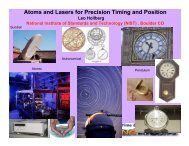Evolution Of The GPS Navigation Payload - Stanford Center for ...
Evolution Of The GPS Navigation Payload - Stanford Center for ...
Evolution Of The GPS Navigation Payload - Stanford Center for ...
Create successful ePaper yourself
Turn your PDF publications into a flip-book with our unique Google optimized e-Paper software.
MDU Controls the Total NAV <strong>Payload</strong> Operation from Atomic<br />
Frequency Standards Through Transmitted Signals<br />
• Mission Data Unit<br />
– Central Processor<br />
– ADA HOL Used Throughout<br />
– Clock Frequency Synthesis from Multiple Standards<br />
– Integral Baseband Processor<br />
– Full Message Encoding and Message Processing<br />
• Crosslink Transponder Data Link<br />
– RF Receive Transmit of Digital Data<br />
– Precision Inter Satellite Ranging<br />
– Frequency Hopped TDMA<br />
– Full Frame Modulation and Mode Control<br />
• Time Standard Assembly<br />
– Multiple Atomic Frequency Standards <strong>for</strong> Reliability<br />
– Accommodates Various Clock Types (Cs, Rb)<br />
– RAD-Hard Upset Proof Design<br />
– Synthesized High Stability <strong>GPS</strong> Timing Signals<br />
– Automated Integrity Monitoring<br />
• L-Band Subsystem<br />
– 25-30 Watt Transmitter<br />
– Bandwidth 20 MHz<br />
– Radiation Hardened<br />
– L1: 1 or 10 Mchip/s Quadraphase<br />
L2, L3: 1 or 10 Mchip/s Biphase<br />
– Space Proven Design Operational on Block I and<br />
Block II<br />
10/22/09<br />
MDU<br />
Use or disclosure of this in<strong>for</strong>mation is subject to the restrictions on the Title Page of this document.<br />
7





